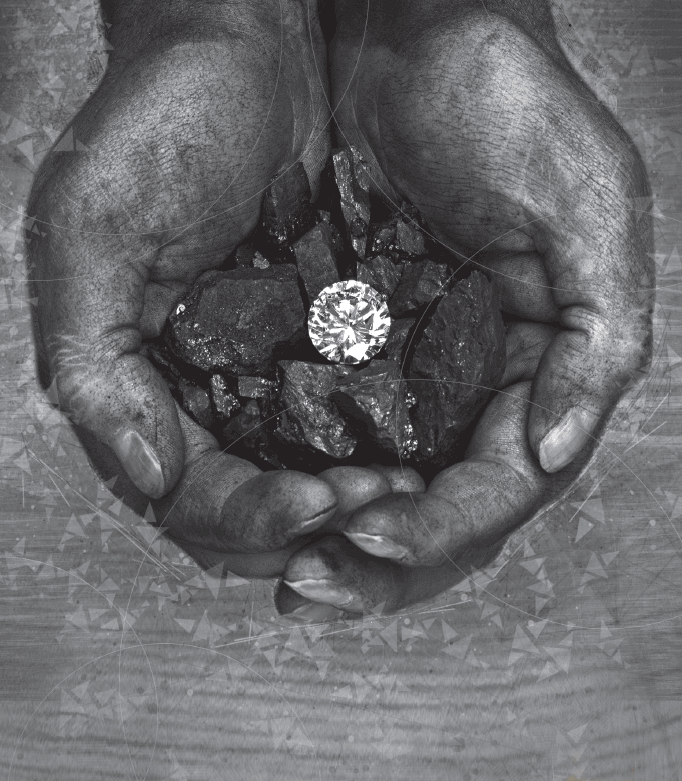

The Power of Chemistry
“It's just like dating!” my colleague exclaimed as he rushed into the room. A recent divorcé, Brian had just discovered online matchmaking websites, so it was with some trepidation that I asked him, “What's just like dating?”
“Business relationships,” he replied.
At that point I was dubious about where the conversation was heading, but then he continued, saying, “It's all about the chemistry.”
Chemistry. A powerful word used to represent that magical something that can exist between people—and not just the romantically inclined. The term is applied broadly, from successful sports teams to highly rated news anchors to popular political leaders. In most cases its presence is obvious, but mysterious. It is hard to know exactly what's behind it. It's just there.
Of course, chemistry is also a branch of science that explores what matter is made of and how those ingredients interact, combine, and change. As a former pre-med student, I vividly recall my afternoons in the organic chemistry lab, carefully titrating this and heating that to create the perfect cocktail that would bring about the particular transformation I was hoping for (rather than an explosion). This other definition of chemistry pertains to the precise, analytical, and measured (literally). And yet the result still somehow feels magical.
Brian's words about business relationships made something click for me. He was right; chemistry is a huge factor in business. And not just in established working relationships, but in any interaction between people, whether they know each other well or not. Once you start looking, its presence or absence is noticeable everywhere. With that colleague you seek out when you want to riff on a new idea versus the one you avoid because he's so difficult to work with. With the client who will work with no one but you, versus the one you can't seem to click with. With the teams that achieve outsized success, versus those that churn and churn and never make progress. Time and again we've seen how chemistry can be the invisible force tilting the outcome in one direction or the other.
We often consider the great chemistry in these situations to be something we either have or don't. We think of it like luck, an abstract boon to wish for but not something to expect. However we rarely question whether there's a way we could concoct it ourselves. What if instead we viewed it as a discipline, one that explores the elements behind human interactions and how they might be brought together to minimize explosions and maximize positive outcomes? What if we took a scientific view on the art of business relationships?

That question kicked off the development of the Business Chemistry Project at Deloitte, which has become a seven-year exploration into what makes people click or clash, why some groups excel and others fumble, and how leaders can make or break team potential. What is Business Chemistry?
In short, it is an analytics-driven tool for understanding and leveraging differences between people. It has been used by hundreds of thousands of professionals around the world to build healthier teams, enhance customer engagement, and become more effective leaders
This book is dedicated to helping you use the principles of Business Chemistry to build your own powerful relationships, high-performing teams, and exceptional organizations.
As one of the original architects of the system, I'm writing this first chapter to lay some groundwork for why we developed this tool in this first place. In the rest of the book my co-author, Suzanne, will join me in sharing some of the most important ways in which people differ, and how those differences can cause conflicts between individuals and inconsistent performance on teams. Think your colleague doesn't get it? Their working style may simply be the opposite of yours. Think some of your team members lack commitment? Your team norms might be draining their energy and sapping their potential. Throughout this book we'll provide you with practical strategies for creating better business chemistry with those you work with, improving the performance of everyone involved. We'll share ideas for how to manage, motivate, and influence different types of people. We'll offer strategies for earning their trust and respect. And we'll explore how to lead your teams so that everyone can excel and deliver their best performance. But in order to get there, it helps to understand first things first.
Origins
The truth is, that early conversation I had with Brian catalyzed a mass of existing interest around this topic within our team. We had noticed that certain people in our organization were consistently outperforming the average, a trend that stayed true even when they switched from one client to another. So we embarked on an effort to better understand what made these individuals special and whether we could help others to perform like them. Our corporate sleuthing revealed that, for the most part, what these outliers were doing was similar to everyone else. They performed the same types of work, on the same size projects, with the same level of expertise. What wasn't the same was their approach to working with others. These star performers weren't just delivering services, they were building relationships—with clients, with their teams, and with one another. Not only that, but it seemed they were what you might call relationship naturals. They didn't appear to consciously think about why they should build relationships or how to build them, they just did it and did it well. They each seemed to be highly attuned to their clients' individual needs, and would frequently talk about “walking in their clients' shoes.” When we spoke with their clients, they couldn't really identify why the relationships were so strong. They would say things like, “He just gets me” or “We complement one another.”
We suspected that the secret sauce for each of these individuals was empathy. Decades of studies have shown that empathy is integral to effective human connection1, and recent research further demonstrates links between empathy and leadership performance2 3, as well as commercial success at the organizational level.4 Our high-performing people seemed to have an extra dose of this important quality, which translated into great chemistry with their clients, colleagues, and teams.
So our hypothesis about empathy was all fine and good, but now we were up against a daunting challenge. We were an organization of well over a hundred thousand people, and growing. If we wanted to scale the success of our high-empathy stars, we'd need to rely on something more than just natural empathic ability. But it wasn't immediately clear what we should do next. After all our digging, we wondered if our investigation had reached a dead end. But it turns out the answer, dear readers, was elementary.
Diamonds are a Firm's Best Friend
Sadly I've forgotten much of what I learned in my college science courses, but my conversation with Brian about parallels between business and dating did unearth one relevant gem of knowledge from the depths of my brain, specifically, a fact about diamonds. See, organic chemistry hinges around the core element carbon. And in its pure state, carbon has two well-known forms, coal and diamonds. (Let's hope Santa doesn't confuse the two when he visits my house this year.)
Naturally occurring, the diamond form of carbon has always been highly valued due to its rarity. As a result, people have long been experimenting with how to transform lesser forms of carbon into high-worth diamonds. The earliest recorded attempts to do so date back to 1797.5 Then finally, in 1954, GE created the first commercially successful synthesized diamond.6 The interesting thing about these cultivated diamonds was that they weren't imitations; they were the real deal, pure carbon crystallized in isotropic 3D forms. In fact, these synthetic diamonds actually possessed some properties that made them superior to naturally formed diamonds, particularly for industrial applications, which require hardness, thermal conductivity, and electron ability.
Thinking about these various forms of carbon, I realized that our outlier performers were “diamonds in our midst.” They possessed something highly valuable and naturally occurring: gem-grade empathy. But if we wanted to raise the performance of all our people to their level, we couldn't rely on nature; we needed to follow the example of the synthetic diamond innovators and figure out a way to cultivate it. And like lab-created diamonds, our cultivated empathy would not only be authentic, we hoped, but superior to organic empathy for business applications. With that clarity, we set off on a journey to figure out how we might help our people become more empathic.
A Matter of Style
If you're going to try to cultivate empathy, it helps to first be clear about what you mean by it. We define empathy as understanding and identifying with another person's perspective. It was this ability we wanted to nurture in our leaders and professionals across the organization. But like bumper sticker advice, this seemed easier said than done. Unless you know someone really well (which often isn't the case in a business environment), you may not even be aware of what their perspective is, let alone really understand or identify with it. And as for coming straight out and asking someone to tell you all about how they see and experience the world? Awkward.
What we needed was a simple way to help people develop empathy—some clue they could detect in a business environment without asking a lot of questions. Something they could directly observe that would correlate strongly with an individual's distinct perspective. That clue turned out to be working style.
Working style is essentially your personality manifest in a business setting. It's a composite of how you process information, make decisions, connect with people, and a multitude of other facets that reflect your unique perspective. By observing whether someone's working style is more spontaneous or structured, more diplomatic or direct, more conceptual or concrete, you can start to get a pretty clear picture of their perspective on things. And while it seems obvious that individuals' working styles differ in significant ways, people often overlook these differences, or see them as nuisances to be tolerated rather than clues to be understood, appreciated, and leveraged. To cultivate empathy, you need to recognize these differences for what they are—useful signals about an individual's perspective, and the building blocks of powerful working relationships.
But in order to fuel that magical chemistry of great business relationships, you need gem-grade empathy. That requires going beyond simply acknowledging differences and building understanding, to acting on that knowledge. As it turns out, those kindergarten lessons to treat others the way you want to be treated only go so far in an environment where the way you like to think, behave, and work is different from what I like. With the kindergarten's Golden Rule in mind, we often default to our own personal working styles and assume others process information, make decisions, and connect with people the same way we do. Then we wonder why that yields mostly frustration, misunderstanding, and wasted potential.

We developed Business Chemistry to highlight some of these important differences in the name of empathy-building. Our goal was to help our people quickly identify someone's working style, understand how it's different from or similar to their own, and then to act on that knowledge by flexing their own style relative to the other person. In other words, treat others as they want to be treated. That's gem-grade empathy. Ultimately, with Business Chemistry we created a working style assessment and framework that makes practical the seemingly magical practice of crafting powerful work relationships.
Building a Better Mouse Trap
Ok, we get it—the idea that people have different personalities, working styles, and ways of being is not exactly new. Since the ancient Greeks, at least, humans have tried to categorize and catalog thoughts and behaviors, feelings and preferences. And we realize that in today's modern times there is no shortage of systems, assessments, and tools available for classifying people's styles, whether in the workplace or in more personal realms, and whether serious and practical or fun and frivolous. (How many online quizzes did you take last month?) We're very aware of the ubiquity of these sorts of surveys and we often start with the following request when introducing Business Chemistry to a group: “Raise your hand if you've taken a personality or working style assessment before.” Rarely does a hand fail to rise.
But then we ask a question: “How many of you, regardless of the assessment you took, can remember what type you are and what that means?” About half the hands go down and the previously self-satisfied expressions turn a bit sheepish. And then we throw out one more question: “How many of you could guess the type of the person next to you, based on a few key observations, and would know how to tailor your interactions accordingly?” At this point eyes look down, heads begin to shake, and perhaps just one or two hesitant hands remain raised at half-mast.
Right. So the concept isn't new, and most everyone has been exposed to these kinds of tools before. However, we've found that: 1) many people don't remember what they learned about themselves much less what they learned about others, and 2) most people don't know or can't remember how to apply that information to create chemistry in their own work relationships.
This is why we set out to develop a new system—one that would be both memorable and actionable. What you'll find is that Business Chemistry is powerful not because it invalidates existing theories or reveals some groundbreaking new discovery about human nature. Quite the opposite, in fact. This system is powerful because it takes a fresh approach to an age-old topic. Built for business, it's purposely designed to be practical and sticky, distilling an often murky subject down to the essence of what really matters for people in a work environment.
The Basics of Business Chemistry
The Business Chemistry types are the focus of the rest of this book, so you're about to learn all about them. For now, though, I'll tide you over with a quick summary. Do you recognize yourself or your colleagues in any of these descriptions?
 |
Pioneers value possibilities and they spark energy and imagination. They're outgoing, spontaneous, and adaptable. They're creative thinkers who believe big risks can bring great things. |
 |
Guardians value stability and they bring order and rigor. They're practical, detail-oriented, and reserved. They're deliberate decision-makers apt to stick with the status quo. |
 |
Drivers value challenge and they generate momentum. They're technical, quantitative, and logical. They're direct in their approach to people and problems. |
 |
Integrators value connection and they draw teams together. They're empathic, diplomatic, and relationship oriented. They're attuned to nuance, seeing shades of grey rather than black and white. |
© 2018. Deloitte Touche Tohmatsu Limited
Of course, we don't all fit neatly into one of these categories. In fact, we are each a unique combination of all four, and depending on the context or situation in which we find ourselves, we may demonstrate behaviors associated with any of the types. Yet most of us find that in general we strongly associate with one or two of the types and that our behavior will be relatively consistent across various situations. For ease of use in this book we'll refer to these four types, and to people resembling them, by using the simple labels of Driver, Integrator, Guardian, and Pioneer. We trust that you, as our readers, will understand that we're using a shortcut. When we refer to someone as a Driver, what we really mean is a person with lots of characteristics closely associated with the Driver type, who thinks and behaves like a Driver much of the time. While the former isn't perfectly accurate, the latter is prohibitively awkward. We thank you in advance for remembering that we're simplifying. (And speaking of simplifying, I know that some of you are really interested in the details about how the system was created and the specifics behind its application. You can find all of that in the appendix.)
Activating the Power of Diversity
Ultimately, the magic of Business Chemistry is not in the types individually, but in their combinations collectively. As you may have already discerned, Guardians and Pioneers have opposite working styles, as do Drivers and Integrators. Business Chemistry can be particularly valuable with diversity like this, helping people work across these kinds of stark differences. But even when differences are more subtle, understanding how to reconcile them and use them to your advantage is crucial for creating great chemistry.
Diversity in the broadest sense—of thought, background, or experience—is often lauded as a driver of performance.7 And most teams and organizations have some level of diversity to draw upon. But even when many different perspectives are represented, leaders often treat people as if they're all the same (that good old kindergarten lesson we mentioned earlier). As a result, they fail to tap into diversity's powerful potential. Furthermore, they inadvertently foster environments that marginalize or neglect to nurture those who are different. And we find they often don't realize they're doing this and don't recognize the negative impact it's having.
In our work with thousands of executives and professionals, we've seen this challenge over and over again: A CEO beats her head against the wall because her team keeps derailing and can't deliver on the strategy. A VP doesn't understand why her team members constantly undercut one another's efforts. A CFO feels his own contributions aren't being valued. These situations could be attributed to sub par talent, incompetent leadership, or poor organizational models, but they could also be caused by unrecognized and underleveraged differences between working styles.
Contrast those scenarios with leaders and teams that actively manage diversity: An executive team dramatically increases effectiveness by tapping into complementary strengths. A CHRO improves performance by letting individuals tailor their work environments to their needs. A director becomes a key contributor to the leadership team by shaping his interactions with others according to their individual styles. In these stories of success, people appreciate diversity, and adapt to make the most of it.
The most successful leaders and teams we've worked with take it one step further. They don't just respond to the working style differences around them, but they actively cultivate diversity—in leadership pairings, within teams, and across organizations—bringing together complementary strengths through thoughtful management. They go beyond flexing on a one-on-one basis to actively appreciating and leveraging the multi-dimensionality of their teams. They create environments that both empower and compel people to make their very best contributions.
This is the true mission of Business Chemistry. To provide a simple, practical way to identify meaningful differences between people's working styles. To grasp where others are coming from, appreciate the value they bring, and determine what they need in order to excel. And finally, to offer ways to act upon that information in order to be more effective as individuals and as leaders. Because while the benefits of diversity are real, they're far from automatic; they must be activated. Each style must be recognized, valued, nurtured, and integrated to create an overall environment where all can thrive.
References
- 1. Harvard Business Review. Empathy. Brighton, MA: Harvard Business Review Press, 2017.
- 2. Sinar, Evan, Rich Wellins, Matthew Paese, Audrey Smith, and Bruce Watt, “High-Resolution Leadership: A Synthesis of 15,000 Assessments into How Leaders Shape the Business Landscape.” Development Dimensions International, Inc, 2016.
- 3. Ovans, Andrea. “How Emotional Intelligence Became a Key Leadership Skill.” Harvard Business Review. May 05, 2015. https://hbr.org/2015/04/how-emotional-intelligence-became-a-key-leadership-skill.
- 4. Parmar, Belinda. “The Most Empathetic Companies, 2016.” Harvard Business Review. December 20, 2016. https://hbr.org/2016/12/the-most-and-least-empathetic-companies-2016.
- 5. Boser, Ulrich. “Diamonds on Demand.” Smithsonian.com. June 1, 2008. https://www.smithsonianmag.com/science-nature/diamonds-on-demand-48545144/.
- 6. Kellner, Tomas. “Diamonds Weren't Forever in the GE Store, but Carbon Will Be.” GE Reports. May 21, 2015. https://www.ge.com/reports/post/119548896365/diamonds-werent-forever-in-the-ge-store-but/.
- 7. Page, Scott E. The Difference: How the Power of Diversity Creates Better Groups, Firms, Schools, and Societies. Princeton, NJ: Princeton University Press, 2007.
